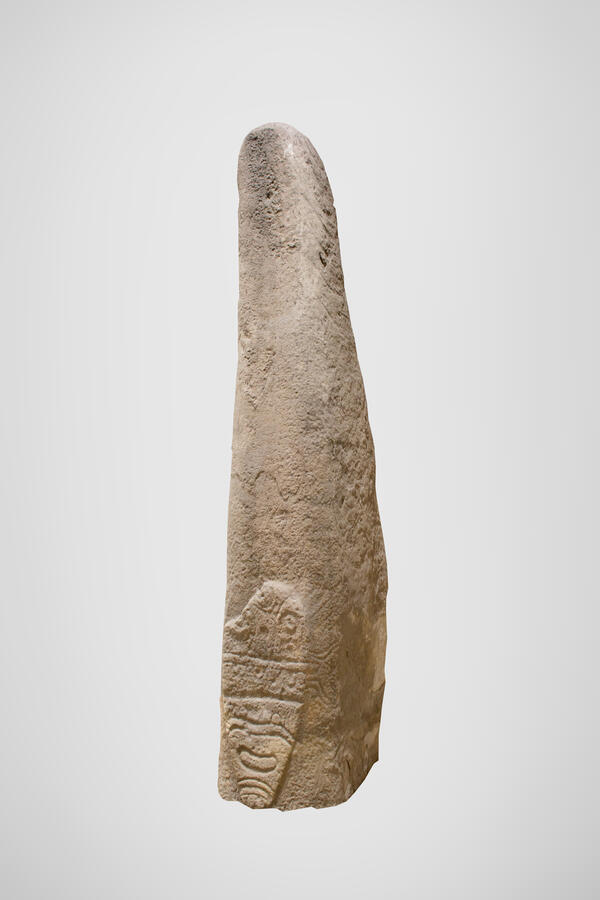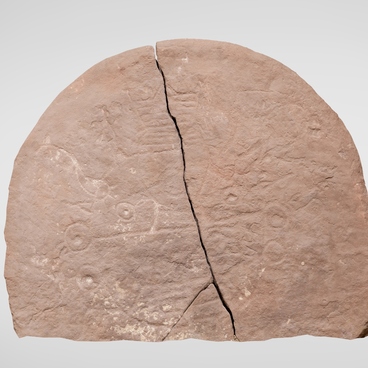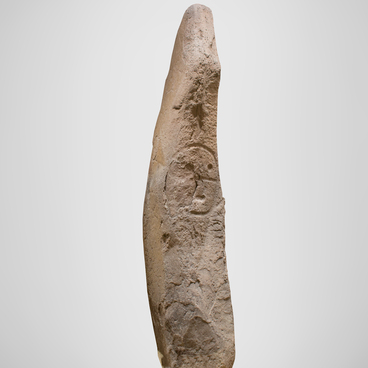Chaatas was the name given by the ancient Khakasses to war graves. This name literally meant a “stone of war”. In some Khakass legends it was said that such mounds were made of fragments of rocks with which the ancient heroes fought.
Menhirs — vertically elongated boulders of roughly processed natural stone — were installed on chaatases. They depicted the so-called masks — the faces of humanoid creatures, probably gods or spirits from Khakass mythology.
A stone stela with a height of more than 3 meters from the collection of the Khakassia National Museum served as a mengir for chaatas, which was located one and a half kilometers from the Askiz station. It was transported to the museum in 1953 by archaeologist Albert Lipsky.
The statue dates from around the end of the 3rd — beginning of the 2nd millennium BC. Its lower part is broken off. On a flat ovoid ledge there is a depiction of a horned face of an unknown deity with three eyes. Two vertical lines outline the nose, two eyes are in the shape of a circle with a hole in the center, and the third is located in the middle of the forehead and is indicated by two concentrated circles. The mouth of the face is wide, looks like an oval groove.
Above the mask there is a barely noticeable image of a snake with an open mouth. In the myths of many peoples, including the Khakass, this reptile belonged to the Lower World, where evil spirits hostile to people lived. However, sometimes a snake or a writhing dragon could symbolize rain and lightning.
On the back of the stela, there is also an image of a dragon with an open mouth, from which fire erupts. It is partially overlapped by another, later drawing — the figure of a deer. In the myths of the Siberian peoples, this animal was often associated with the sun and good deities. This is probably due to the fact that deer served as the main source of meat and therefore gradually began to symbolize life.
Lines and holes on one of the lateral planes of the sculpture form another mask. It also has three eyes: this motif is characteristic of the Khakass stone masks, created about 5,000 years ago. The third eye consists of three regular circles with a dot in the center and is located slightly above the other two.
Menhirs — vertically elongated boulders of roughly processed natural stone — were installed on chaatases. They depicted the so-called masks — the faces of humanoid creatures, probably gods or spirits from Khakass mythology.
A stone stela with a height of more than 3 meters from the collection of the Khakassia National Museum served as a mengir for chaatas, which was located one and a half kilometers from the Askiz station. It was transported to the museum in 1953 by archaeologist Albert Lipsky.
The statue dates from around the end of the 3rd — beginning of the 2nd millennium BC. Its lower part is broken off. On a flat ovoid ledge there is a depiction of a horned face of an unknown deity with three eyes. Two vertical lines outline the nose, two eyes are in the shape of a circle with a hole in the center, and the third is located in the middle of the forehead and is indicated by two concentrated circles. The mouth of the face is wide, looks like an oval groove.
Above the mask there is a barely noticeable image of a snake with an open mouth. In the myths of many peoples, including the Khakass, this reptile belonged to the Lower World, where evil spirits hostile to people lived. However, sometimes a snake or a writhing dragon could symbolize rain and lightning.
On the back of the stela, there is also an image of a dragon with an open mouth, from which fire erupts. It is partially overlapped by another, later drawing — the figure of a deer. In the myths of the Siberian peoples, this animal was often associated with the sun and good deities. This is probably due to the fact that deer served as the main source of meat and therefore gradually began to symbolize life.
Lines and holes on one of the lateral planes of the sculpture form another mask. It also has three eyes: this motif is characteristic of the Khakass stone masks, created about 5,000 years ago. The third eye consists of three regular circles with a dot in the center and is located slightly above the other two.



